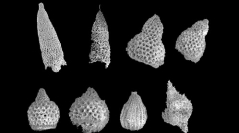

 Geodiversitas
26 (2) - Pages 185-206
Geodiversitas
26 (2) - Pages 185-206A well preserved Cretaceous radiolarian fauna was recovered from the Sistan Suture zone (eastern Iran). This radiolarian fauna was obtained from the red argilaceous cherts and green-grey cherts that distributed in the ophiolite unit. It is regarded as representative of the Early Cretaceous assemblage in the oceanic basin created by the opening of the two blocks (Afghan and Lut) during the Cretaceous time. During the Early Cretaceous, an extensive sedimentation of radiolarian-rich facies occured in this region. Two radiolarian assemblages are determined: Assemblage I (composed of about 15 species which represent the early Aptian), and Assemblage II (characterized by the occurrence of about 32 species). The cryptothoracic Nassellaria correspond to Holocryptocanium barbui Dumitrica, 1970, Dorypyle communis (Squinabol, 1903), etc. The cryptocephalic Nasselaria is only confined to Diacanthocapsa cf. ovoidea Dumitrica, 1970. The spumellarian genera are Dactyliodiscus cf. lenticulatus (Jud, 1994), Pseudoaulophacus sp., etc. The study of the radiolarites provides new data for dating the primary opening between two blocks. It is proposed that the oceanic opening of the two blocks occurred prior to the early Aptian.
Radiolarian assemblages, Early Cretaceous, eastern Iran, Sistan Suture, Gazik Province